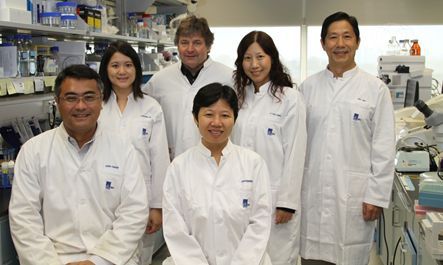A triple threat against viral diseases

Researchers have identified a new macromolecule that could help prevent deadly virus infections with a triple-play mechanism that can also help prevent viral drug resistance.
The discovery could result in the breakthrough needed to fight viral infections, which often escape vaccines due to their natural ability to mutate rapidly and develop drug resistance easily.
In a study published in the journal Macromolecules, scientists from IBM Research and Singapore’s Institute of Bioengineering and Nanotechnology (IBN) exploited supramolecular chemistry — the study of large molecules designed with multiple features — to help combat viral infection. They created a macromolecule composed of several specialised components that create a powerful triple-play action that helps fight viral infection and replication while inhibiting drug resistance:
- Attraction. One specialised component of the macromolecule enables strong hydrogen bonds with electrostatic interactions to attract the proteins on the virus surface, disabling viral ability to infect healthy cells.
- Prevention. Mannose (a type of sugar) components of the macromolecule bind directly to healthy immune cell receptors to help fight viral infection and allow the free flow of these naturally protective cells.
- Neutralisation. Another component of the macromolecule, known as basic amine groups, neutralises the pH inside the viral cell, making it inhospitable for replication.

The researchers aimed to design a very flexible macromolecule and surveyed a variety of representative viruses from various categories, including Ebola, dengue, Marburg, influenza, Chikungunya, Enterovirus 71 and herpes simplex. In early testing, they found no resistance. Also, by targeting both viral proteins and host-virus interactions, the antiviral macromolecule sidesteps the normal mutations that enable viruses to escape vaccines through the onset of resistance.
“We have created an antiviral macromolecule that can tackle wily viruses by blocking the virus from infecting the cells, regardless of mutations,” said Dr Yi Yan Yang, group leader, IBN. “It is not toxic to healthy cells and is safe for use.”
IBM cognitive computing tools will be able to carry the initial research further — for example, as the macromolecule progresses to the clinical trial stage, IBM Watson Discovery Advisor can draw connections between disparate datasets to speed new insights. Enabled by cognitive computing, IBM Watson for Clinical Trial Matching enhances clinicians’ ability to easily find clinical trials for which a patient may be eligible, increases the likelihood that the patient is offered the option of a clinical trial for treatment and helps increase clinical trial fulfilment.
In the short term, the macromolecule could be used for applications such as antiviral wipes or detergents, which would require a small amount of the macromolecule dispersed in water to potentially neutralise an entire room infected with Ebola, for example. Potential longer-term applications may include the development of a new mode of vaccination that could help prevent a whole category of viral infections.
Mast cell test simplifies the diagnosis of food allergies
In the Hoxb8 mast cell activation test (Hoxb8 MAT), mast cells grown in the laboratory are...
A science-based solution for tackling lake health
Experts urge moving away from short-term 'fixes' that only worsen a lake's condition...
Climate report warns of perilous times ahead
Scientists have warned that the Earth is stepping into a critical and unpredictable new phase of...




